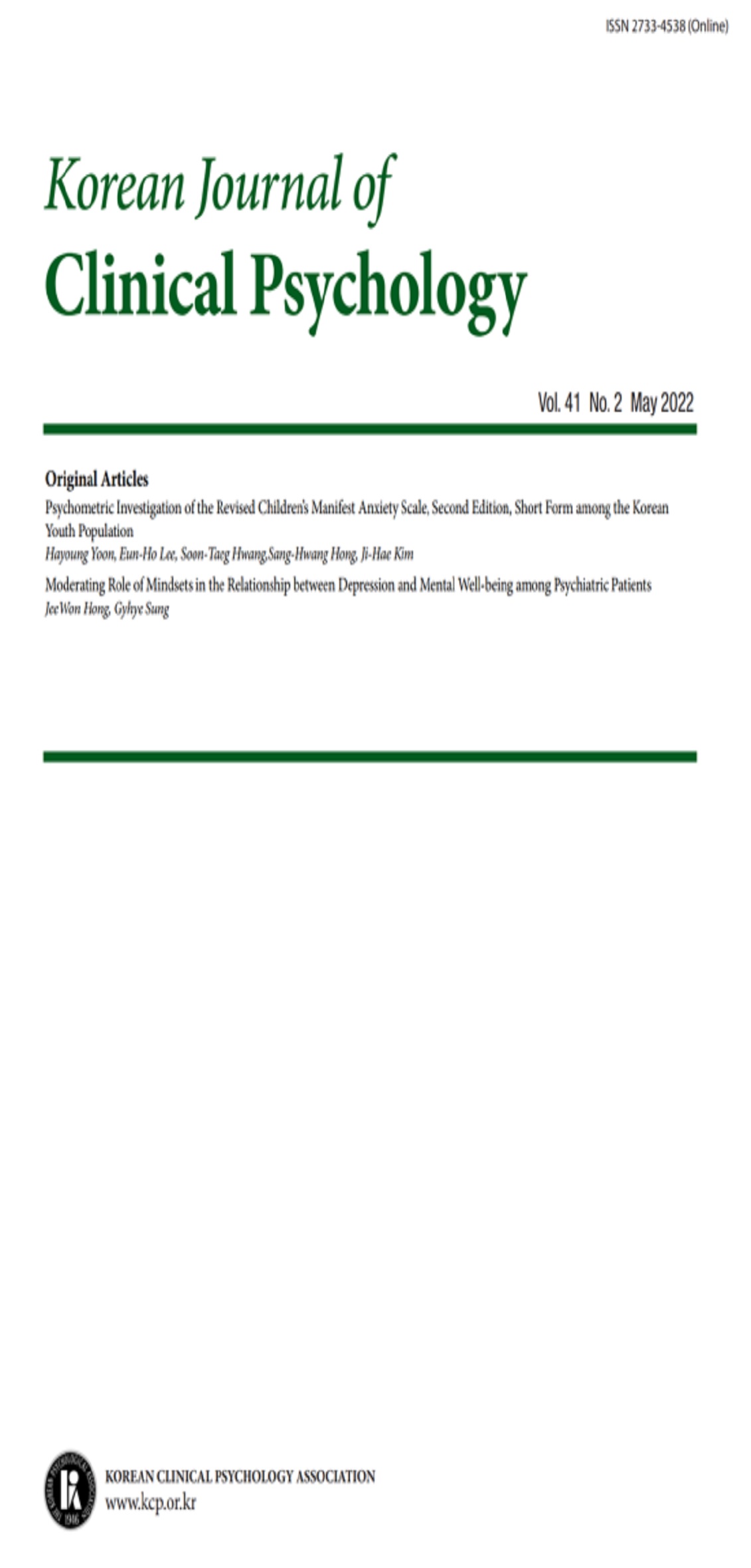open access
메뉴
open access
메뉴 E-ISSN : 2733-4538
E-ISSN : 2733-4538
This study examined the influences of the adolescent‘s negative automatic thoughts on the internalizing and externalizing problems. And it also tested whether negative automatic thoughts are broadband specific features that distinguish internalizing disorders from externalizing disorders, and are narrowband specific features that distinguish depression from delinquent problems. The study sample was 1982 adolescents(916 boys and 966 girls) from junior and high school, and they completed self administered questionnaires such as K-YSR, CES-D and LDQ. The regression analysis showed that the externalizing problems as well as internalizing problems were predicted by the negative automatic thoughts in linear and quadratic terms. But it showed the negative automatic thoughts had much more explanations on the internalizing problems. Both the internalizing only and comorbid with externalizing problem groups reported significantly more negative automatic thoughts. And both the depressive only and comorbid with delinquent problem groups reported significantly more negative automatic thoughts. These showed that the negative automatic thoughts are narrowband specific as well as broadband specific features in adolescent's psychological disorders.
(1993) 청소년기 우울과 비행간의 관계 인지적 몰락을 매개변인으로,
(2002) 한국판 아동청소년용 자동적 사고척도(K-CATS)의 타당화 연구,
(1991) 한국에서의 the Center for Epidemiological Studies-Depression Scale 의 사용-표준화 및 요인구조에 대한 횡문화적 검토-,
(2005) 부정적 자동적 사고 질문지(ATQ-N)와 긍정적 자동적 사고 질문지(ATQ-P)의 타당화 연구: 청소년 집단을 대상으로,
(2001) K- YSR 청소년 자기행동평가척도, 중앙적성출판사
(2004) 한국판 무망감 우울증상 척도의 타당화 연구: 청소년 대상으로.,
(2002) 아동청소년의 우울 및 불안과 관련된 부정적 자기진술: 한국판 부정적 자기진술 질문지(Negative Affect Self-Statement Questionnaire)의 타당화 연구,
(2005) 청소년기 정서 및 행동문제의 성차,
(2005) 청소년기 부정적 자동적 사고가 우울증상에 미치는 영향,
(1991band1991profiles) Manual for the Youth Self-Report University of Vermont,
(1993) Automatic cognitions and the symptoms of depression and anxiety in children and adolescents:An examination of the content specificity hypothesis,
(1979) Cognitive therapy of depression, Guilford Press
(1990) Cognitive therapy of personality of depression, & Associates Guilford Press
(1987) A test of the cognitive content-specificity hypothesis Journal of Abnormal Psychology, Differentiating anxiety and depression
(1992) Comorbidity of anxiety and depression in children and adolescents,
(1997) Social expectancies and self-perceptions in anxiety- disordered children,
(1996) Social information-processing mechanisms in reactive and proactive aggression,
(1997) Information processing in clinically depressed and anxious children and adolescents ,
(1996) Cognitive specificity and affective confounding in social anxiety and dysphoria in children,
(2001) A prospective test of the hopelessness theory of depression in adolescence,
(1996) Tripartite structure of positive and negative affect and anxiety in child and adolescent psychiatric inpatients ,
(1995) Attributional style and depression in children and adolescents:A meta-analytic review,
(1992) Cognitive Triad Inventory for Children Development and relation to depression and anxiety Journal of Clinical Child Psychology,
(2000) Externalizing and internalizing behaviors during 8 years of childhood ,
(1993) Cognitive-behavioral therapies with youth Journal of Consulting and Clinical Psychology,
(1993) Cognition in the psychopathology of youth and implications for treatment,
(1995) Cognitive-behavioral treatments,
(1990) Cognitive deficit or cognitive distortion in childhood depression Journal of Abnormal Child Psychology,
(1994) Cognitive distortions and psychiatric diagnosis in dually diagnosed adolescents Journal of American Academy of Child and Adolescent Psychiatry,
(1986) Negative cognitive errors in children and comparisons between children with and without self-reported symptoms of depression Journal of Consulting and Clinical Psychology,
(1998) Can cognitive distortions differentiate between internalising and externalising problems ,
(1998) Children's self-talk under conditions of mild anxiety ,
(2002) A longitudinal study of children's depressive symptoms, self-perceptions, and cognitive distortions about the self.,
(1992) Role of aggression and attributions in the prediction of depression in children,
(1992) Depressive self schemas in clinic and nonclinic children,
(1992) Social information processing in aggressive and depressive children,
(1995) Cognitions and stress: Direct and moderating effects on depressive versus externalizing symtoms during the junior high school transition ,
(2001) Development and validation of a measure children's automatic thoughts : The Children's Automatic Thoughts Scale,
(2004) The structure of negative self-statements among children and adolescents:A confirmatory factoranalytic approach,
(1996) Aggressive boys' hostile perceptual and response biases:The role of attention and impulsivity,
(1984) Negative affectivity:The disposition to experience aversive emotional states,
(1998) Common and specific features of childhood psychopathology,
(1988) Thai and American perspectives on over and undercontrolled child behavior problems Exploring the threshold model among patents Journal of Consulting and Clinical Psychology,
(1988) Thai and American perspectives on over and undercontrolled child behavior problems Exploring the threshold model among patents Journal of Consulting and Clinical Psychology,
